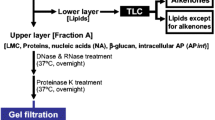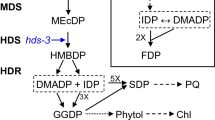Abstract
Phyllodia of the Crassulacean acid metabolism (CAM) plant Kalanchoë tubiflora were allowed to fix 13CO2 in light and darkness during phase IV of the diurnal CAM cycle, and during prolongation of the regular light period. After 13CO2 fixation in darkness, only singly labelled [13C]malate molecules were found. Fixation of 13CO2 under illumination, however, produced singly labelled malate as well as malate molecules which carried label in two, three or four carbon atoms. When the irradiance during 13CO2 fixation was increased, the proportion of singly labelled malate decreased in favour of plurally labelled malate. The irradiance, however, did not change either the ratio of labelled to unlabelled malate molecules found in the tissue after the 13CO2 application, or the magnitude of malate accumulation during the treatment with label. The ability of the tissue to store malate and the labelling pattern changed throughout the duration of the prolonged light period. The results indicate that malate synthesis by CAM plants in light can proceed via a pathway containing two carboxylation steps, namely ribulose-1,5-bisphosphate-carboxylase/oxygenase (EC 4.1.1.39) and phosphoenolpyruvate carboxylase (EC 4.1.1.31) which operate in series and share common intermediates. It can be concluded that, in light, phosphoenolpyruvate carboxylase can also synthesize malate independently of the proceeding carboxylation step by ribulose-1,5-bisphosphate carboxylase/oxygenase.
Similar content being viewed by others
Abbreviations
- CAM:
-
Crassulacean acid metabolism
- PEP:
-
phosphoenolpyruvate
- PEPCase:
-
phosphoenolpyruvate carboxylase (EC 4.1.1.31)
- RuBPCase:
-
ribulose-1,5-bisphosphate carboxylase/oxygenase (EC 4.1.1.39)
- TMS:
-
trimethylsilyl
References
Avadhani, P.N., Osmond, C.B., Tan, K.K. (1971) Crassulacean acid metabolism and the C4-pathway of photosynthesis in succulent plants. In: Photosynthesis and photorespiration, pp. 288–293. Hatch, M.D., Osmond, C.B., Slatyer, R.O., eds. Wiley, New York
Biemann, K. (1962) Mass spectrometry. Organic chemical applications. McGraw-Hill, New York
Björkman, O., Osmond, C.B. (1974) Effect of oxygen on carbon dioxide fixation in Kalanchoë daigremontiana. Carnegie Instn. Washington YrbK. 73, 852–858
Bradbeer, J. W., Ranson, S.L., Stiller, M.L. (1958) Malate synthesis in Crassulacean leaves. I. The distribution of 14C in malate of leaves exposed to 14CO2 in the dark. Plant Physiol. 33, 67–70
Buchanan-Bollig, I.C., Fischer, A., Kluge, M. (1984) Circadian rhythms in Kalanchoë: the pathway of 14CO2 fixation during prolonged light. Planta 161, 71–80
Buchanan-Bollig, I.C., Smith, J.A.C. (1984) Circadian rhythms in Crassulacean acid metabolism: phase relationships between gas exchange, leaf water relations and malate metabolism in Kalanchoë daigremontiana. Planta 161, 314–319
Cockburn, W., McAulay, A. (1975) The pathway of carbon dioxide fixation in Crassulacean plants. Plant Physiol. 55, 87–89
Fischer, A., Kluge, M. (1984) Studies of carbon flow in Crassulacean acid metabolism during the initial light period. Planta 160, 121–128
Holtum, J.A.M., Summons, R., Roeske, C.A., Comins, H.N., O'Leary, M.H. (1984) Oxygen-18 incorporation into malic acid during nocturnal carbon dioxide fixation in Crassulacean acid metabolism plants. J. Biol. Chem. 259, 6870–6881
Kluge, M. (1969) Veränderliche Markierungsmuster bei 14CO2-Fütterung von Bryophyllum tubiflorum zu verschiedenen Zeitpunkten der Hell/Dunkelperiode. 1. Die 14CO2-Fixierung unter Belichtung. Planta 88, 113–129
Kluge, M., Bley, L., Schmid, R. (1975) Malate synthesis in Crassulacean acid metabolism via a double CO2 dark fixation? In: Environmental and biological control of photosynthesis, pp. 281–288, Marcelle, R., ed Junk, The Hague
Kluge, M., Brulfert, J., Queiroz, O. (1981) Diurnal changes in the regulatory properties of PEP-carboxylase in the CAM. Plant Cell Environ. 4, 251–256
Kluge, M., Fischer, A., Buchanan-Bollig, I.C. (1982) Metabolic control of CAM. In: Crassulacean acid metabolism, pp. 31–50, Ting, I.P., Gibbs, M., eds. Am. Soc. Plant Physiologists, Rockville, Md., USA
Kluge, M., Kriebitzsch, Ch., v. Willert, D.J. (1974) Dark fixation of CO2 in Crassulacean acid metabolism: are two carboxylation steps involved? Z. Pflanzenphysiol. 72, 460–465
Kluge, M., Ting, I.P. (1978) Crassulacean acid metabolism: analysis of ecological adaptation. Ecological Studies, vol. 30. Springer, Berlin Heidelberg New York
Lüttge, U., Smith, J.A.C., Marigo, G. (1982) Membrane transport, osmoregulation, and the control of CAM. In: Crassulacean acid metabolism, pp. 69–91. Ting, I.P., Gibbs, M., eds. Am. Soc. Plant Physiologists. Rockville, Md., USA
Möllering, H. (1974) L-Malat. In: Methoden der enzymatischen Analyse, pp. 1636–1639, Bergmeyer, H.U., ed. Verlag Chemie, Weinheim
Osmond, C.B. (1978) Crassulacean acid metabolism: a curiosity in context. Annu. Rev. Plant Physiol. 29, 379–414
Osmond, C.B., Allaway, W.G. (1974) Pathways of CO2 fixation during photosynthesis in Kalanchoë daigremontiana. I. Patterns of 14C fixation in the light. Aust. J. Plant Physiol. 1, 503–512
Osmond, C.B., Holtum, J.A.M. (1981) Crassulacean acid metabolism. In: The biochemistry of plants, vol. 8: Photosynthesis pp. 283–338, Hatch, M.D., Boardman, N.K., eds. Academic Press, New York London
Popp, M., Osmond, C.B., Summons, R.E. (1982) Pathway of malic acid synthesis in response to ion uptake in wheat and lupin roots: evidence from fixation of 13C and 14C. Plant Physiol. 69, 1289–1292
Sutton, B.G., Osmond, C.B. (1972) Dark fixation of CO2 by Crassulacean plants. Evidence for a single carboxylation step. Plant Physiol. 50, 360–365
Wilkins, M.B. (1983) Temporal control of phosphoenolpyruvate-carboxylase activity in leaves of Bryophyllum fedtschenkoi: an explanation of phase regulation in the circadian rhythm by light and high temperature signals. Physiol. Vég. 21, 997–1005
Winter, K. (1982a) Carbon dioxide and water vapor exchange in the Crassulacean acid metabolism plant Kalanchoë pinnata during a prolonged light period. Metabolic and stomatal control of carbon metabolism. Plant Physiol. 66, 917–921
Winter, K. (1982b) Properties of phosphoenolpyruvate carboxylase in rapidly prepared, desalted leaf extracts of the Crassulacean acid metabolism plant Mesembryanthemum crystallinum L. Planta 154, 298–308
Winter, K., Tenhunen, J.D., (1982) Light-stimulated burst of carbon-dioxide uptake following nocturnal acidification in the Crassulacean acid metabolism plant Kalanchoë daigremontiana. Plant Physiol. 70, 1718–1722
Author information
Authors and Affiliations
Rights and permissions
About this article
Cite this article
Ritz, D., Kluge, M. & Veith, H.J. Mass-spectrometric evidence for the double-carboxylation pathway of malate synthesis by Crassulacean acid metabolism plants in light. Planta 167, 284–291 (1986). https://doi.org/10.1007/BF00391428
Received:
Accepted:
Issue Date:
DOI: https://doi.org/10.1007/BF00391428




